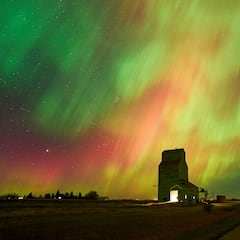What is a geomagnetic storm and how does it affect Earth?
A “severe” geomagnetic storm is approaching our planet, with a fantastic light show expected to grace North American skies.


A major geomagnetic storm is expected to hit Earth on Thursday, potentially leading to colorful auroras visible further south than usual in the United States.
The storm, classed as “severe” by the US’s Space Weather Prediction Center (SWPC), is being driven by a series of coronal mass ejections (CMEs) from the Sun, which began erupting this week. These are solar flares emitted by the Sun which, once they reach our planet, interact with the atmosphere to create stunning visuals.
The most mesmerising consequence is the creation of auroras. These shimmering light displays, known as the northern lights (aurora borealis) and southern lights (aurora australis), appear when charged particles collide with gases in the atmosphere.
“It’s essentially the Sun shooting a magnet out into space,” Bill Murtagh, program coordinator for the SWPC, told Nexstar media. “That magnet impacts Earth’s magnetic field and we get this big interaction.”
Where can you see this week’s auroras in North America?
While the northern lights are usually confined to the Arctic circle, hence the name, the severity of this week’s flares means the beautiful sight may be seen as far south as US states such as Alabama and California.
According to a viewline prediction by the SWPC, the best places in North America to catch a glimpse of this week’s anticipated auroras - which are expected to be visible on both Thursday and Friday - are locations like Alaska and Canada.
What is a geomagnetic storm?
The Sun is a star filled with constant activity, sending a stream of charged particles called solar wind towards Earth. This wind is usually harmless, deflected by our planet’s magnetosphere - a magnetic shield.
Related stories
However, sometimes the Sun throws more forceful punches in the form of these CMEs. These bursts of particles can cause geomagnetic storms, temporary disturbances in the magnetosphere with surprising earthly effects.
While beautiful, geomagnetic storms can also disrupt radio signals used by aircraft, ships, and even GPS. In extreme cases, they can induce currents powerful enough to damage power grids, causing blackouts. “Detrimental impacts to some of our critical infrastructure technology are possible,” the SWPC has said of this week’s storm.


Complete your personal details to comment